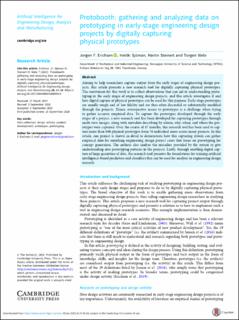| dc.contributor.author | Erichsen, Jorgen Falck | |
| dc.contributor.author | Sjöman, Heikki | |
| dc.contributor.author | Steinert, Martin | |
| dc.contributor.author | Welo, Torgeir | |
| dc.date.accessioned | 2022-03-08T10:20:52Z | |
| dc.date.available | 2022-03-08T10:20:52Z | |
| dc.date.created | 2021-06-23T14:38:37Z | |
| dc.date.issued | 2021 | |
| dc.identifier.citation | Artificial intelligence for engineering design, analysis and manufacturing. 2021, 35 (1), 65-80. | en_US |
| dc.identifier.issn | 0890-0604 | |
| dc.identifier.uri | https://hdl.handle.net/11250/2983732 | |
| dc.description.abstract | Aiming to help researchers capture output from the early stages of engineering design projects, this article presents a new research tool for digitally capturing physical prototypes. The motivation for this work is to collect observations that can aid in understanding prototyping in the early stages of engineering design projects, and this article investigates if and how digital capture of physical prototypes can be used for this purpose. Early-stage prototypes are usually rough and of low fidelity and are thus often discarded or substantially modified through the projects. Hence, retrospective access to prototypes is a challenge when trying to gather accurate empirical data. To capture the prototypes developed through the early stages of a project, a new research tool has been developed for capturing prototypes through multi-view images, along with metadata describing by whom, why, when, and where the prototypes were captured. Over the course of 17 months, this research tool has been used to capture more than 800 physical prototypes from 76 individual users across many projects. In this article, one project is shown in detail to demonstrate how this capturing system can gather empirical data for enriching engineering design project cases that focus on prototyping for concept generation. The authors also analyze the metadata provided by the system to give understanding into prototyping patterns in the projects. Lastly, through enabling digital capture of large quantities of data, the research tool presents the foundations for training artificial intelligence-based predictors and classifiers that can be used for analysis in engineering design research. | en_US |
| dc.language.iso | eng | en_US |
| dc.publisher | Cambridge University Press | en_US |
| dc.rights | Navngivelse 4.0 Internasjonal | * |
| dc.rights.uri | http://creativecommons.org/licenses/by/4.0/deed.no | * |
| dc.title | Protobooth: Gathering and analyzing data on prototyping in early-stage engineering design projects by digitally capturing physical prototypes | en_US |
| dc.type | Peer reviewed | en_US |
| dc.type | Journal article | en_US |
| dc.description.version | publishedVersion | en_US |
| dc.source.pagenumber | 65-80 | en_US |
| dc.source.volume | 35 | en_US |
| dc.source.journal | Artificial intelligence for engineering design, analysis and manufacturing | en_US |
| dc.source.issue | 1 | en_US |
| dc.identifier.doi | 10.1017/S0890060420000414 | |
| dc.identifier.cristin | 1917978 | |
| cristin.ispublished | true | |
| cristin.fulltext | original | |
| cristin.qualitycode | 1 | |

